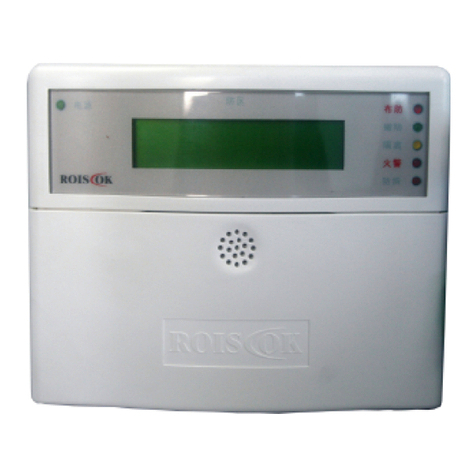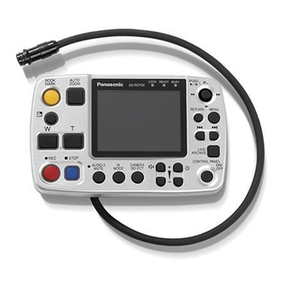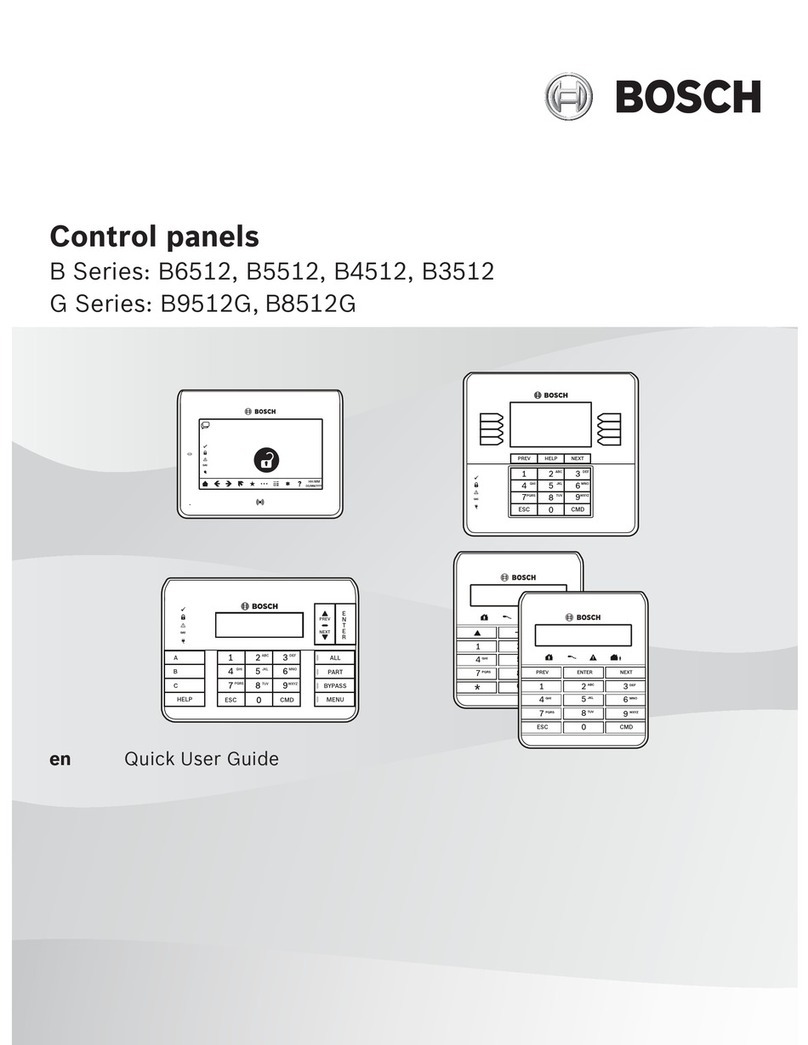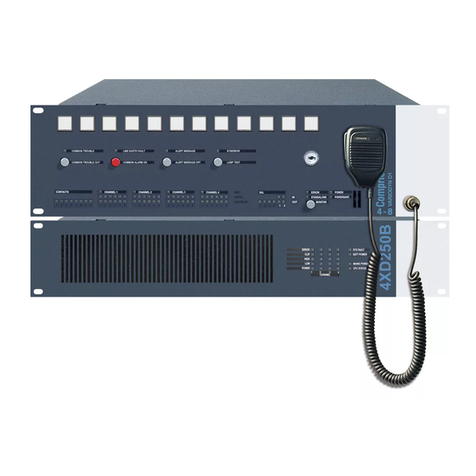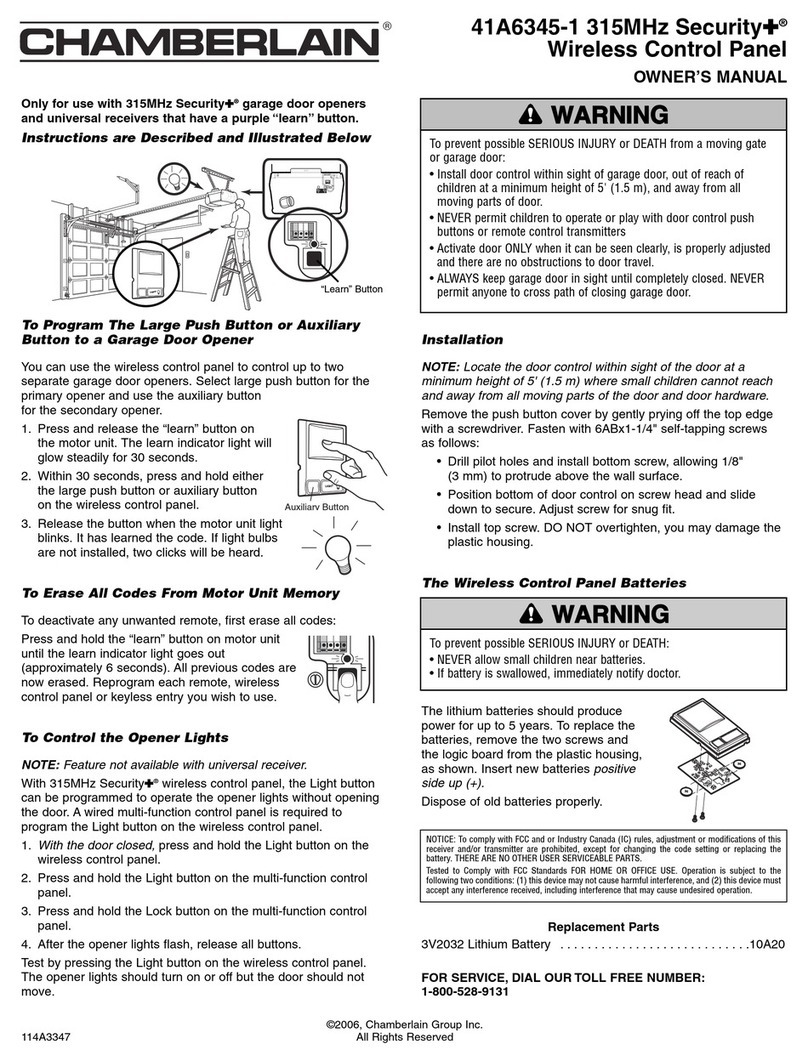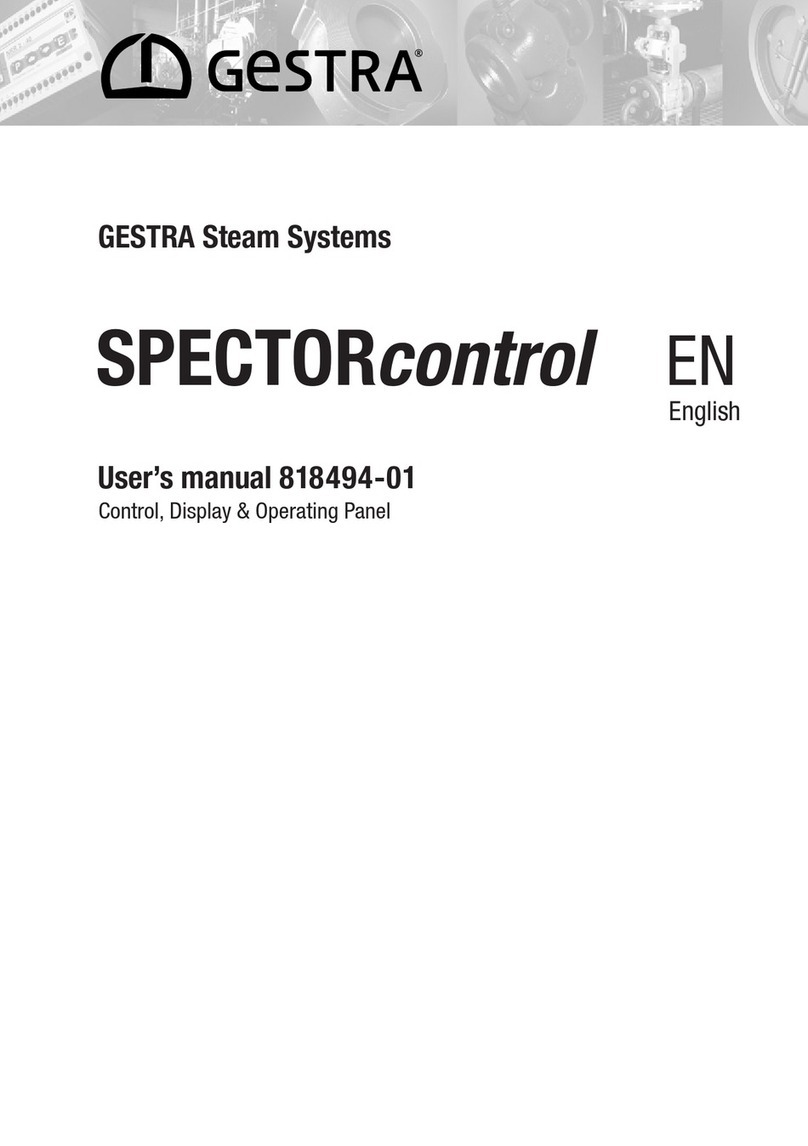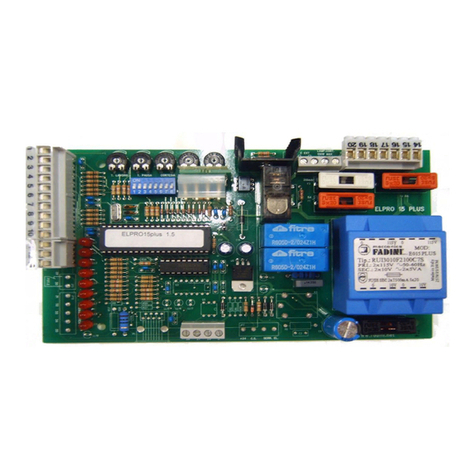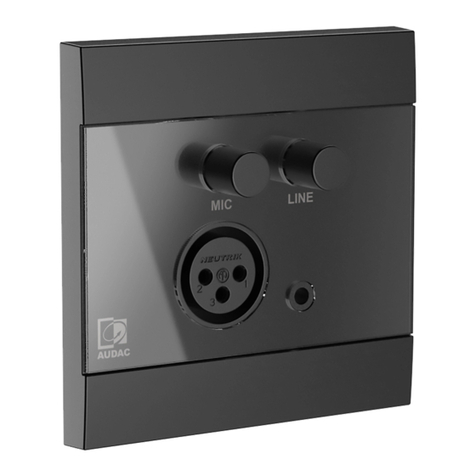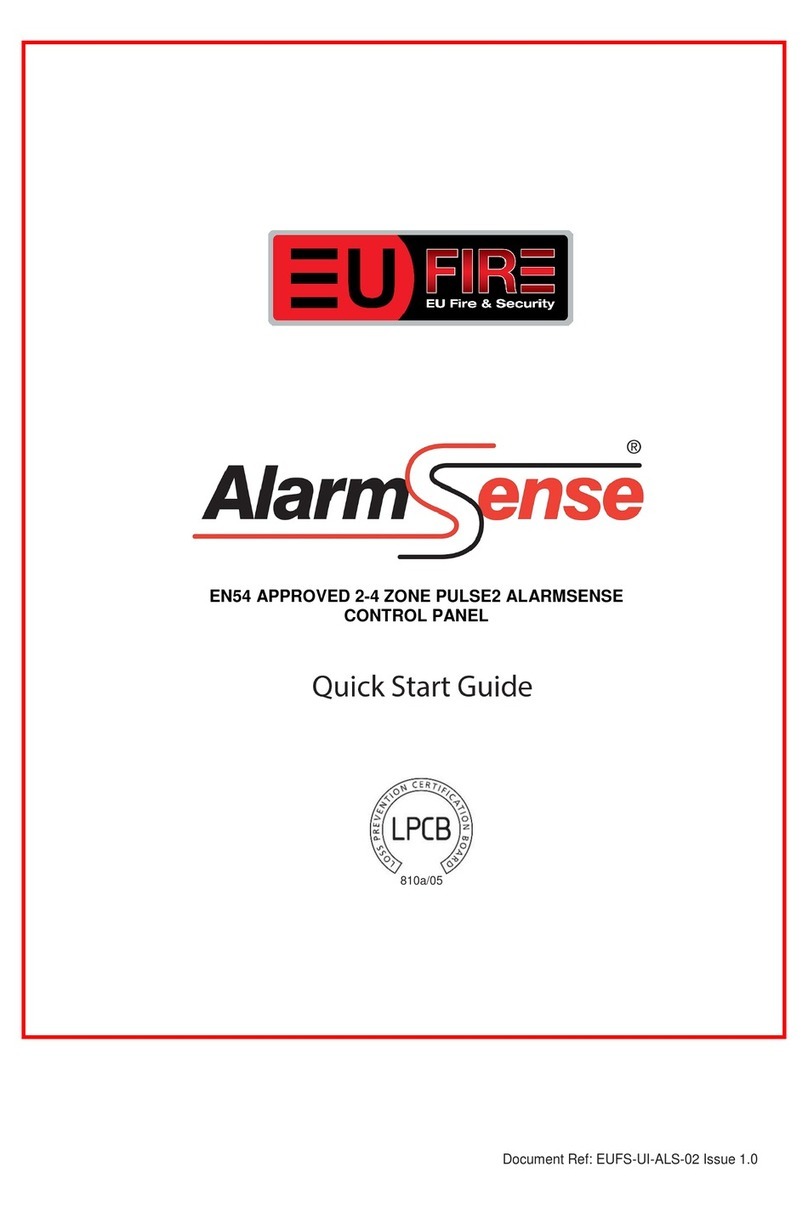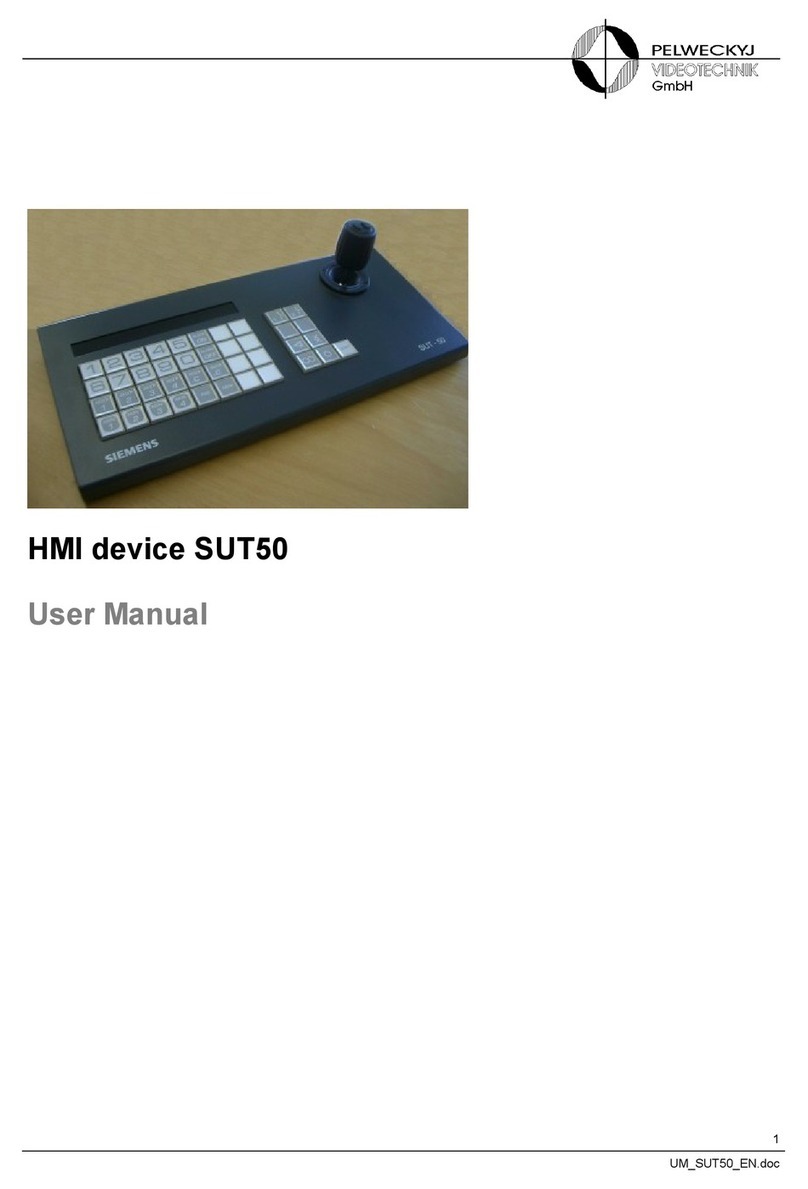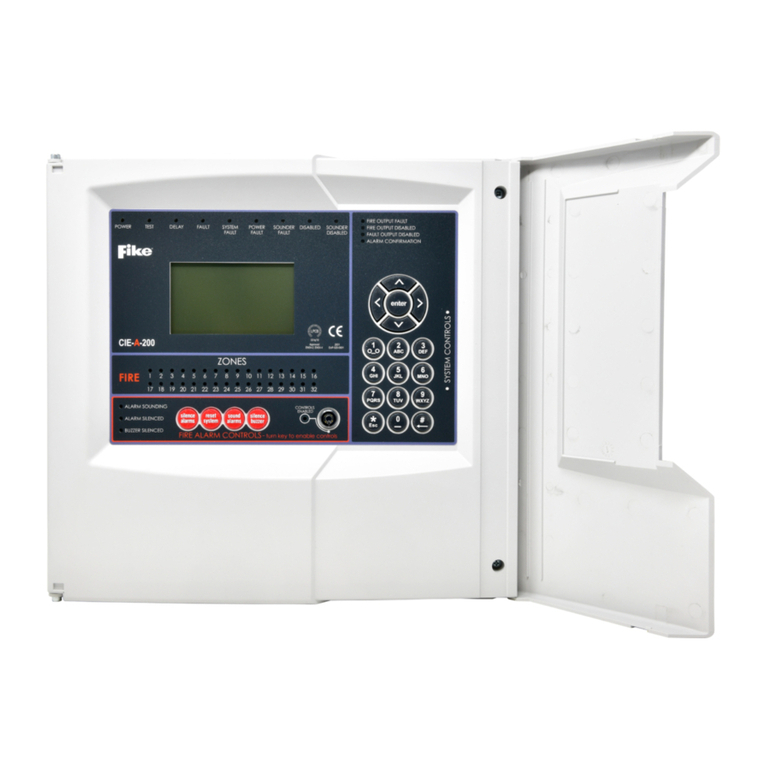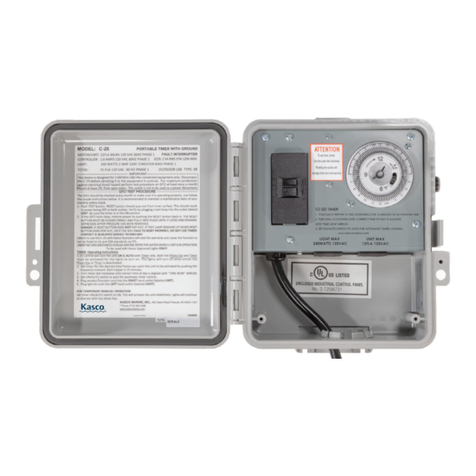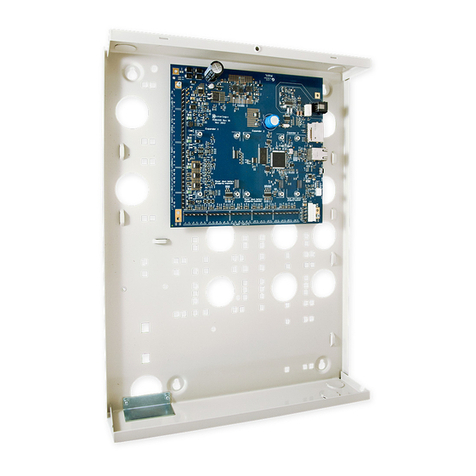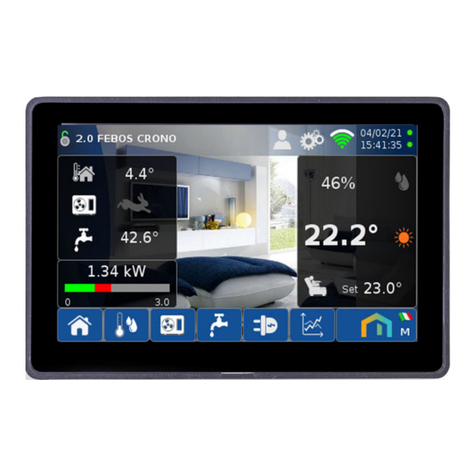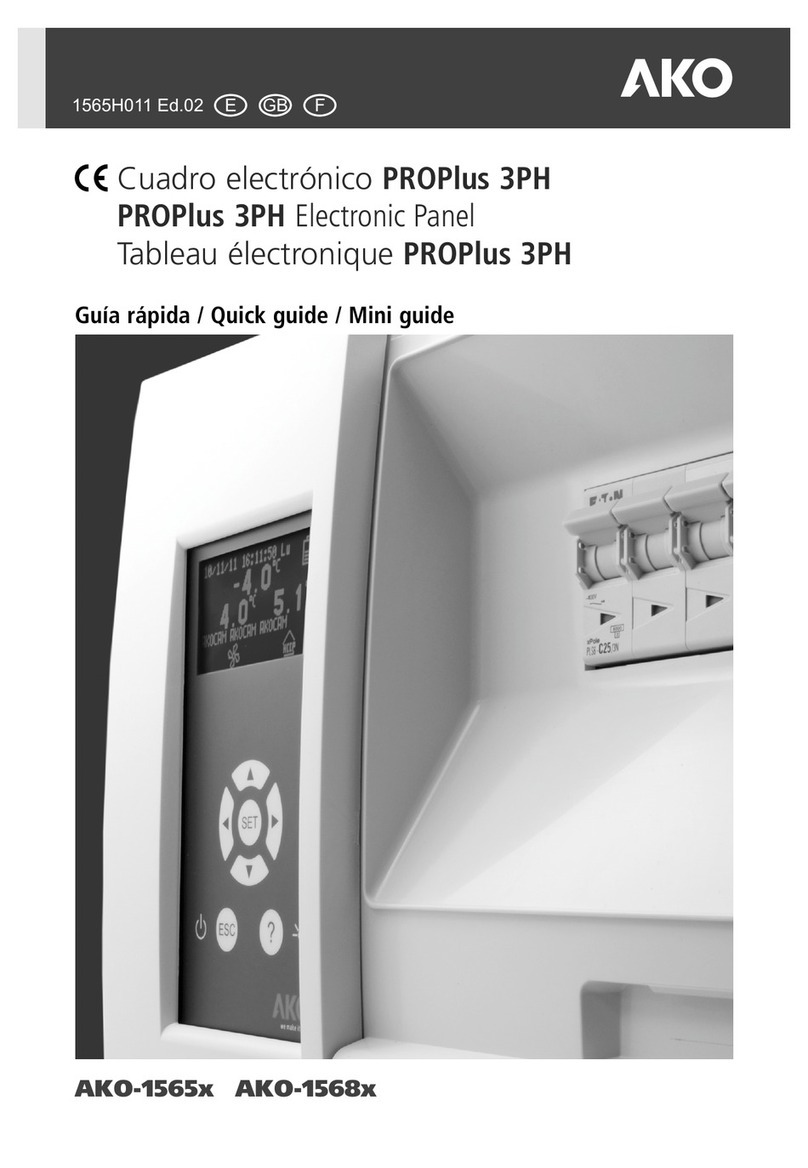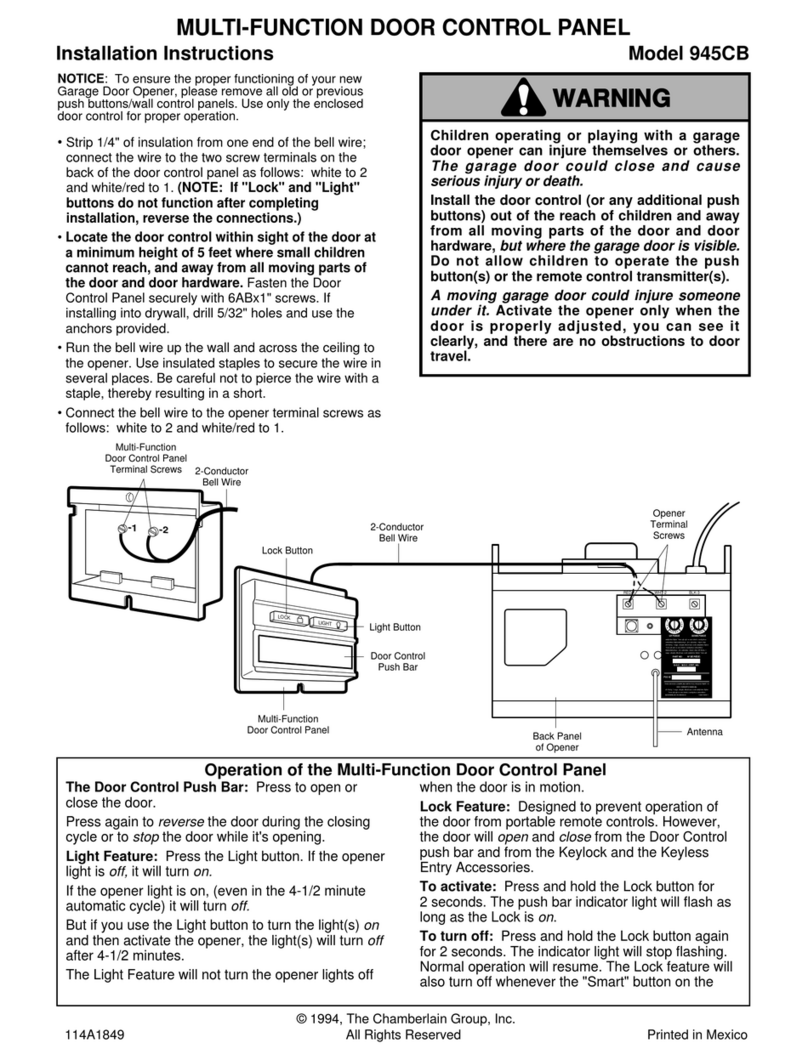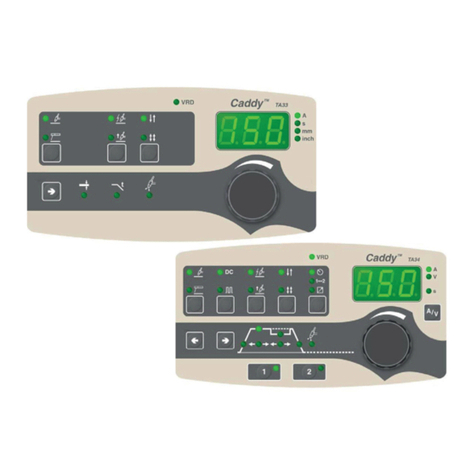Roiscok RP248CN Use and care manual

RP248CN User’s and Installer’s Manual
INDEX
CHAPTER 2 – ABOUT THE KEYPAD.............................................................................2
RP248KCL(LCD KEYPAD)................................................................................................2
KEYS AND LED INDICATORS ...............................................................................................2
3.1 DEPRESS KEYS AUDIBLE ...............................................................................................4
3.2 DOOR CHIME.................................................................................................................4
3.3 THE NUMERIC KEYS AND CHARACTER RELATIVE FORM..................................................4
3.4 DIGIT KEYS AND FUNCTIONS KEYS...............................................................................4
3.5 MODIFYING/SETTING AND DELETING CODE.................................................................4
3.6 Set date and time..................................................................................................5
3.7 Set follow-me numbers ........................................................................................6
3.8 Arm and arm sound..............................................................................................6
3.9 Disarm and disarm sound....................................................................................6
3.10 Duress code disarm ...........................................................................................7
3.11 Stop siren/bell and stop dialing a number.......................................................7
3.12 Bypass and un-bypass zone(s)........................................................................7
3.13 Exit a error operation..........................................................................................7
3.14 Keypad alarm......................................................................................................7
3.15 Entry delay and exit delay.................................................................................8
3.16 Trouble and display.............................................................................................8
3.17 Zones characters................................................................................................8
3.19 System Partition and Control............................................................................9
CHAPTER 4 SYSTEM INSTALL EXPLAIN ..................................................................10
4.1 PREPARATION BEFORE INSTALLATION...........................................................................10
4.2 FQA OF INSTALLATION AND SOLUTION.......................................................................10
4.3 MAIN BROAD LAYOUT AND PORT FUNCTION DESCRIPTION:.......................................10
4.5 CONNECT THE TELEPHONE LINE..................................................................................12
4.6 CONNECT THE STANDBY BATTERY ..............................................................................12
4.7CONNECT TRANSFORMER.............................................................................................12
4.8 CONNECT SIREN/BELL.................................................................................................12
4.9 CONNECT DETECTOR(S)...............................................................................................12
4.10 CONNECT VOICE MODULE.........................................................................................12
CHAPTER 5 - FUNCTION AND TECHNICAL DATA...................................................14
5.1 FEATURES OF RP248KCL............................................................................................14
5.2 FEATURES OF RP248MBAND EXPANSION MODULES ..................................................14
5.3 TECHNICAL DATA.........................................................................................................17
CHAPTER 6 PROGRAMMING DIRECTION.................................................................18
6.1 PROGRAMMABLE ITEMS...............................................................................................18
6.2 RESTORE FACTORY DEFAULTS ....................................................................................18
6.5.1 SPECIAL EXPLAIN..........................................................................................18
6.5.2 SYSTEM PROGRAM......................................................................................18
6.5.3 Set Zones..........................................................................................................22
6.5.4 Programmable Utility Output..........................................................................27
6.5.5 Code Maintenance...........................................................................................29
6.5.6 Dialer..................................................................................................................29
6.5.7 Report Code......................................................................................................31
6.5.8Add Keypad and Module..................................................................................31
6.6 COMMUNICATION PROTOCOLS.....................................................................................32
6.7 RP248CN CONTROL PANEL CONTACT ID REPORTING CODES ....................................33

RP248CN User’s and Installer’s Manual Page 1
CHAPTER 1- SUMMARY of USER’S COMMANDS
The Summary of User’s Commands offers installers and users a quick and convenient way
to operate control panel. All can be done under the state of disarm and so it doesn’t need to
entry programming statue. For detailed information, please go chapter 2 and chapter 3.
No Function Procedure
1 Quick arm [ARM]
2 Arm by code [master code] + [ARM]
3 Arm Stay zones [STAY]
4 Arm Stay zones by code [ master code] + [STAY]
5 System disarm [user code]+[#]
6 Duress disarm [duress code]+[#]
7 Free from siren [user code]+[#]
8 Bypass zone [*]+[1] [1]+[user code] +[#]+[zone number]
9 Un-bypass zone [*]+[1] [2]+[user code] +[#]+[zone number]
10 Utility output [*]+[2][1]
11 Set follow-me phone No. [*]+[2][7]+[ user code] +[#]+ (1-8)+[ phone No.] +[#]
12 Display trouble [*]+[3][1] +[user code] +[#]
13 Display triggered record [*]+[3][2] +[user code] +[#]
14 Display unready zone [*]+[3][3] +[user code] +[#]
15 Display zone state [*]+[3][4] +[user code] +[#]
16 Display memory [*]+[3][5] +[user code] +[#]
17 Test keypad [*]+[4][1] +[user code] +[#]
18 Test Stand-by battery [*]+[4][2] +[user code] +[#]
19 Off door chime [*]+[4][3] +[user code] +[#]
20 On door chime [*]+[4][4] +[user code] +[#]
21 Off partition door chime [*]+[4][5] +[user code] +[#]
22 On partition door chime [*]+[4][6] +[user code] +[#]
23 Off buzzer [*]+[4][7] +[user code] +[#]
24 On buzzer [*]+[4][8] +[user code] +[#]
25 Walk test [*]+[4][0]
26 Set/change users code [*]+[5] +[user code] +[#]
27 Set time [*]+[6]+[1] +[user code] +[#]
28 Set date [*]+[6]+[2] +[user code] +[#]
29 Next Auto arm time [*]+[6]+[3] +[user code] +[#]
30 Next Auto disarm time [*]+[6]+[4] +[user code] +[#]
31 Auto arm [*]+[6]+[5] +[user code] +[#]
32 Auto disarm [*]+[6]+[6]
33 Auto stay arm [*]+[6]+[7]
34 keypad panic alarm [1]+[2] at least 2 seconds
35 keypad fire alarm [4]+[5] at least 2 seconds
36 keypad special
emergency
[7]+[8] at least 2 seconds
37 Escape [ESC]
Trouble List
LCD Display Trouble
MAIN:LOW BATT Battery Power low
MAIN:AC TROUBLE AC lost
MAIN:BELL LOOP Siren trouble
FALSE CODE P=1 Code error
KITCHEN:FIR Fire Loop in trouble
KP=03 COMM TRBL The bus in trouble, such as No.3 keypad is in
trouble
SYSTEM CLCOK Clock not set
PS= 1 LOW BAT Power Module Battery low. Such as No.1
power Expansion Module is in trouble
PS=1 AC TRBL Power Module in AC Trouble. Such as No.1
power Expansion Module is in trouble
PS=1 BELL TRBL Power Module Siren in Trouble. Such as No.1
power Expansion Module is in trouble
PS=1 AUX TRBL Power Module Stand-by Power is low. Such
as No.1 power Expansion Module is in trouble
PHONE LINE Phone line in trouble
FIRE DOOR:DAY Day time zone in trouble.

RP248CN User’s and Installer’s Manual Page 2
CHAPTER 2 – ABOUT THE KEYPAD
RP248KCL(LCDKeypad)
The control panel RP248CN supports LCD Keypad. Each main board can work with 16 LCD
Keypads at most.
The keypads display system status by its LED indicators and LCD display. Through its keys,
can arm and disarm the system, bypass intrusion zones, report emergencies, stop the siren,
stop calling follow-me number, checking the trouble, program the system etc.
Fig.1 Layout of the RP248KCL
Keys Instruction
1-PowerLED
2-LCD Display
3-ArmLED
4-Disarm LED
5-Bypass LED
6-Fire LED
7- Tamper LED
8-Digit and Function key-press
9-Armkey-press
10-Buzzer
11-Stay Arm key-press
KeysandLEDindicators
The Keys functions:
1. For Arming, Disarming, Panic Alarm, Programming system etc.
2. Entry user’s function mode.
3. Key [ARM] is for quick arming and code arming. When arm by [ARM], the system will
be fully armed.
4. Key [STAY] is for quick stay arming and code stay arming. Any zone or zones can be
set as interior zone(s) or external zone(s). When arming by [STAY], the external zone(s)
will be armed while leaves the interior zone(s) disarmed.
5. Under the disarmed status, depress [*] to entry user’s function mode for setting code,
clock, on/off the buzzer and so on. For detail, go to CHAPTER 1- SUMMARY of
USER’S COMMANDS
1. Power LED
On--the system AC power supply is in normal and the stand-by battery is in good
condition.
Off—no AC power supply and stand-by battery is in power lack.
Fast flicker—system in trouble.
Slow flicker—system is in users function.
2. LCD Display
The LCD Display on RP248KCL indicates the system status, including zones triggered,
armed/disarmed system, system trouble, time and other programmed information.
Normally the LCD Display indicates partition No., clock, date and weekday as following:
PARTITION 1
10.18 JAN 10 THU
3. ARM LED
On-- system is armed.
Off-- system is disarmed or under the programming state.
Flicker-- The system is under the delay period state.

RP248CN User’s and Installer’s Manual Page 3
4. READY LED
The Ready LED indicates whether the system is under ready or not, and also whether
system can be armed or not.
On-- The system is ready to be armed now.
Off-- The system is not ready to be armed now.
Flicker-- The system is ready for arming, and at the same time some especial zone(s) with
entry /exit delay is triggered.
5. BYPASS LED
When BYPASS LED on, one or more zone(s) has/have been bypassed or under stay statue.
6. FIRE LED
The LED flicker rapidly when lighting.
7. TEMPER LED
When the detector(s), the keypad or the Expansion Module is /are tempered or destroyed, a
Tamper Code report will be sent and the LED will be lighting.
8. Digit Keys
When programming, key in 0-9 digits.
Under the state of users function, quick go to the menu.
9. System Arming [ARM]
When depress [ARM] key, all the zones are armed. The LED Display delay time.
Under the user functional state, the key [ARM] is used to set data. For example, when
setting the clock, [ARM] can be used to choice the month, weekday and partition.
10. Keypad Buzzer
The buzzer is used for indicating the entry/exit delay, alarm, door chime and so on.
11. Stay Home Arming [STAY]
When depress [STAY] key, the interior zones will not be armed. During stay arming, the
LCD display the delay time.
Under user function, the [STAY] key is used to set data. For example, when setting the
clock, [STAY] is used to choice month, weekday and partition.
12. Function Key [*]
Depress [*] Key into the function set ting state.
Back t o the anterior menu or return to the normal state.
13. Confirm Key [#]
The Key [#] used for confirm and save input data.
14. Moving Key [←][→]
Key [←] is used to choice the anterior command, or moving the cursor to left.
Key [→] is used to choice the next command, or moving the cursor to right.
15. Panic Alarm Key [1]+[2]
Depress [1]+[2] at least 2 seconds, the system will send a panic alarm message to CMS or
following-me numbers.
16. Fire Alarm Key [4]+[5]
Depress [4]+[5] at least 2 seconds, the system will send a fire alarm message to CMS or
following-me numbers.
17. Special Emergency Key[7]+[8]
Depress [7]+[8] at least 2 seconds, the system will send a special emergency message to
CMS or following-me numbers.

RP248CN User’s and Installer’s Manual Page 4
CHAPTER 3–SYSTEM FUNCTION AND OPERATION
3.1DepressKeysAudible
When depress any keys, keypad will emit a brief deep.
After any successful operation the keypad will emit a long beep to confirm. And after error
operation, the keypad will emit three brief beep warn.
When arming, the keypad(s) will beep until the end of the exit delay time.
When trigger an armed zone, the keypad will beep until end the entry delay time. The
system must be disarmed, if not, it will be triggered.
If zone(s) programmed as door chime function, when triggered the zone(s), keypad will
emit three short beeps.
When use keypad for panic alarm, fire alarm and special emergency, there will be a brief
beep.
When triggered alarm, keypad will emit a beep for confirming.
It will not change the setting for siren/bell after change the buzzer setting on the keypad.
3.2DoorChime
Each keypad can emit a continuous brief sound, called as DOOR CHIME. If you set the door
chime function, the keypad will emit a door chime sound when the door or window is opened.
Turn on/off the door chime by operation [*]+[4]+[master]+[5] or [6].
3.3Thenumerickeysandcharacterrelativeform
Program as the following:
1. The Key [←] and [→] are used move the cursor to the left or to the right.
2. Key in the character as the above form, such as depress [1] twice to entry the “A” and
depress [2] four times to entry the “P”.
3. After entry one character, move the cursor to entry other one by Key [←][→].
4. After program, depress [#] to confirm, or depress [*] to cancel.
3.4DigitKeysandFunctionsKeys
The Keys can support the following functions:
1. Entry digit(s) for arming, disarming, panic alarm, programming system etc.
2. Entry user’s function mode.
3. Key [ARM] is for quick arming and code Arming.
4. Key [STAY] is for quick stay arming and code stay arming. Each zone can be set as
interior zone or external zone. When use [STAY] for arming, the external zone is armed
while leaves the interior zone disarmed.
5. Under the disarmed status, depress [*] to entry user’s function mode. Reference to
CHAPTER 1- SUMMARY of USER’S COMMANDS
3.5Modifying/SettingandDeletingCode
The Master Code of RP248CN could be set as four or six digit code. The default master
code is 1-2-3-4. Unless your alarm company has already changed it to suit your preference,
it’s best to modify this code to one which is unique and personalized. RP248CN can set a
great deal of codes, one is master code and others are users’ code. The system code can
be set under the disarm state.
Functions of the Master Code:
Change the master code
Distribute, delete and change the system user’s code.
Access to all zones.
Bypass zone(s).
Operation and testing.
Setting the follow-me numbers
Turn on the buzzer.
Turn off the buzzer.
Keys
1 A B C D E F G H I J K L M
2 N O P Q R S T U V W X Y Z
3 ! “ & ‘ : - ? . / ( ) [ ]
4 a b c d e f g h i j k l m
5 n o p q r s t u v w x y z
6
7
8
9
0

RP248CN User’s and Installer’s Manual Page 5
Check the system.
Display and delete memory.
Display troubles.
Setting the system clock time and date.
Setting auto arm time and auto disarm time.
Function of the Users code:
Arm or disarm the system.
Bypass zone(s).
Access one or more zones.
Check the system.
Setting the Users Codes
Through the LCD keypad to set codes, according to the following steps:
1. Depress [*][5] into access function Mode, then depress [*] to find the menu ” ACCESS
CODE ” by [←][→], depress [#] to confirm and into the menu.
2. Key in the master code (default: 1234 ), then depress [#] to confirm.
3. To choice a menu by [←][→].
a) Changing the master codes when display “00 1234 GRANG”.
b) Changing the User No.1 code when display “01 0 USER”.
c) …
4. Key in a new code and confirm by depress [#]. Finish the change when LCD display
“ACCEPTED”
5. Depress [*] to back to anterior menu Back t o the menu or
6. Depress [*] twice, the system will return to the normal state. Then the power LED is on,
LCD display partition, clock, date, etc..
Modifying/Setting the master Code
Modifying/Setting User’s Codes
Deleting User’s Codes
At times, it may be desirable to completely delete a user code. Note that it is impossible to
delete the master code (although it can be changed).
3.6Setdateandtime
Set date: [*]+[6]+[2]+[MASTER CODE]+[MM][DD][YY]
step Operation
1 In disarm state, depress[*][5] to entry into function state
2 Input 4 digit master code then depress [#] to confirm, such as
[1][2][3][4][#]
3 Input new 4 digit code then depress [#] to confirm, such as
[5][6][7][8][#]
4 If successful, the keypad will emit a confirming tone “Beep-”.
The selected User Code is now in effect.
5 Exit by depress [*][*]
6 If operate incorrectly, depress [*] to back to the step 2
Step Operation
1 In disarm state, depress [*][5] to entry into function state
2 Entry Master Code: such as [5][6][7][8]
3
Modify/set user 1 code, depress[0] [1] or
Modify/set user 2 code, depress[0] [2] or
…
The other user codes can be modify/set in the same way.
4 Entry the new user code:
For example, [3][3][5][5]
5 If successful, the keypad will emit a confirming tone “Beep-”.
Step Operation
1 In disarm state, depress [*][5] to entry into user function state
2 Entry the master code: [5 ][ 6][7 ][8 ]
3
To delete the user code 1, depress [1]
To delete the user code 2, depress [2]
To delete the user code 3, depress [3]
…
The other user s can be deleted in the same way.
4 Entry the [0][#] to delete this User Code
5 If successful, the keypad will emit a short confirming beep.

RP248CN User’s and Installer’s Manual Page 6
Set time: [*]+[6]+[1]+[MASTER CODE]+[HH][MM]
Use a 24-Hour format. Hour and Minute should be two digits.
For example, if you want to entry 16:28, August 18, 2006, operate as:
[*]+[6]+[2]+[MASTER CODE]+[AUG][18][2006]
[*]+[6]+[1]+[MASTER CODE]+[16] [28]
3.7Setfollow-menumbers
(Refer to the chapter 6, section 6.5.6 for detail operation)
When alarm, RP248CN control panel can report the alarm events (burglar alarm, fire alarm,
rob alarm, emergency alarm) to one or several follow-me number(s) which has been set,
and distinguish different alarm events with different sound.
RP248CN has menu function for convenient operation. In normal state, depress
[*][2][7][master code][#] can entry into setting follow-me number and modify state. Up to 8 of
follow-me numbers can be set in the system. Depress [←][→] to move cursor left and right.
When setting follow-me number(s), should select the partition number first and then input
telephone number(s), and depress [#] to confirm.
3.8 Arm and arm sound
Quick arm
Any partition of RP248CN can be programmed or distinguished as stay partition and exterior
partition.
Key [ARM] for quick arm all zones/partitions of the system. Please leave away from all the
partitions during the delay time.
Key [STAY] for quick stay arm all of the exterior partitions/zones, and stay partitions/zones
would not be triggered. Please leave away from all the stay partitions / zones immediately.
Arm with code
There are two ways to arm RP248CN, quick arm and code arm. Default is quick arm. If
users need to code arm, please program the system as code arm function in advance. The
system should be armed by [master code] + [ARM], and be partitions armed by [master
code] + [STAY].
Arm sound
According to the default, after exit delay time, the system will make a sound to confirm the
system has entered into arm state. Cancel arm sound, please refer to chapter 6 section
6.5.2
3.9 Disarm and disarm sound
Disarm system
RP248CN can set several groups of 4 digits or 6 digits code in advance, one of them is
master code, and others for users. All of the code can disarm system.
Disarm sound
As the default, RP248CN will emit a long beep to confirm disarm successfully. Input [*]+[4]+
Steps Description
1
Check the disarm LED indicator. If on, the system can be
armed; if off, system can’t be armed, check whether every
partition is ready or there is any trouble.
2
Quick arm:
Quick arm: depress [ARM]
Quick stay arm: depress [STAY]
3 If operate incorrectly, the keypad will emit three short beeps, try
it again please
4
When arming, the keypad will beep until the end of exit delay
time. Please leave before end of exit delay. Default exit delay
time is 30s.
Steps Description
1
When entry into an armed zone, the keypad will emit beep
to warn the system exit delay is begin. The default delay
time is 30s.
2
disarm
Before end of entry delay, please input a code and [#] to
disarm, or else the system will alarm
If code incorrectly, the keypad will emit three short
beep. depress [*] and input code again.
3
Check keypad LCD display status:
“XXXXXX DISARMED”-- no alarm when armed;
“XXXX:ALARM/ NOV 01,07 18:15 →”-- alarmed and
the alarm time.
4 Key [←][→] use to check other alarmed events

RP248CN User’s and Installer’s Manual Page 7
[7] or [8 ] + [master code] can turn on or off the disarm sound
3.10Duresscodedisarm
When be forced, suggest user using duress code to disarm the system. Disarm system
through duress code it will report a duress message to the alarm centry to for help without
any siren or buzzer on.
Any disarm code (master code and users code) add 1 to the last digit is to be duress code.
Such as: if the disarm code is 1234, then the duress code will to be 1235. if code is 7890,
then the forced code is 7891.
3.11Stopsiren/bellandstopdialinganumber
When entry, the below display on the keypad means alarmed event:
Arm LED indicator is flickering
LCD display ZONE XX ALARM
In any situation, input disarm code the system will stop siren/bell stop dialing follow-me
numbers.
3.12 Bypass and un-bypass zone(s)
Check the zone status
In normal, input [*][3][4] and user/master code and depress [#] to confirm. LCD will display
as follows, the character of second line means zone number, zone description and zone
status:
ZONESTATE(0:01)
01)ZONE 01:G ↓
For armed system: G-means zone is in good arm status, B-means zone is in bypass status;
For disarmed system: R-means zone is in ready status, B-means zone is in bypass status,
N-means zone is in unready status
Key [←] [→] are used to check each zone status. Depress [*] or wait few seconds, the
system will auto return to normal status.
Bypass zone(s)
In normal, input a correct user code and depress [→]. If quick bypass is allowed, depress [→]
to bypass this zone directly. LCD displaying as follows:
BYPASS ZONE:(CL)
01 ZONE 01 N ↓
The first line means the zone status, second line means whether the zone is bypassed or
not. Use key [→] to choice other zone(s), use key [STAY] to exchange [Y] and [N], and
depress [#] to confirm.
For disarmed system: CL-means zone(s) is closed, OP-means zone(s) is triggered.
For armed system: AR- means zone(s) is armed, CL-means zone(s) is not triggered but
bypassed, OP- means zone(s) is triggered but bypassed, AA- means zone(s) armed.
Cancel bypass
Choose a zone number, use [STAY] exchange ”Y” to “N”, and depress [#]
Bypass reset
Under user function state, use key [←][→] to choose 2)BYPASS RECALL, and depress [#]
to confirm. Input a correct user/master code and [#] If quick arm is allowed, need not input
code). LCD will display as follows, depress [#] to confirm bypass reset:
BYPASS RECALL
HIT [#] TO CONFIRM
Exit user function state
Depress [*] two times, exit user function state. In normal, the power LED indicator will turn
on.
3.13Exitaerroroperation
When operate incorrectly, depress [*] to cancel and then operate again.
3.14Keypadalarm
RP248CN’s keypad (RP248KCL) has 3 groups of emergency buttons for reporting intrude

RP248CN User’s and Installer’s Manual Page 8
alarm, fire alarm or medical alarm. All of the emergency alarm is silence alarm in default.
Depress [1] and [2] together at least 2 seconds for intrude alarm.
Depress [5] and [6] together at least 2 seconds for fire alarm.
Depress [7] and [8] together at least 2 seconds for medical alarm.
3.15Entrydelayandexitdelay
Your security system must incorporate in and from the premises without causing
inadvertent alarms. A delay period was chosen during your system’s installation to provide
suitable time to allow for your entry and exit. Entry/Exit Delays can be set by programming,
and it’s defaulted as 30 seconds. To change the delay time, refer to location 6.5.3 of
Chapter 6.
3.16 Trouble and display
When keypad emits regular beeps, the system has some trouble. After remove trouble, the
system will return to normal. System trouble includes low battery, loss of AC power, clock
not set, communication trouble and bell loop trouble. Depress [*]+[3] +[1] to check the
event detail on the LCD. Depress [←][→] to check last or next event.
Trouble list is as follows:
3.17Zonescharacters
Every zone of RP248CN can be appoint its character, such as delay zone, instant zone,
emergency zone, firm zone, tamper zone, remote zone, utility output zone and so on. 24
hours character will be always armed, no matter the system armed or not. As long as it is
triggered, it will be alarm. Such as emergency zone, tamper zone, emergency button, fire
zone and so on.
Delay zone: which has character of entry delay or/and exit delay. Exit delay is the period
from the time depress [ARM]/[STAY] to the system armed. Entry delay is the max time from
entry to disarm the system. Beyond delay time, will occur the system alarm.
Instant zone: system alarm as soon as the zone triggered.
Emergency zone:be used to connect emergency button, 24-hours armed.
Fire zone:be used to connect smoke and gas detectors, 24- hours armed.
Tamper zone: be used to connect detector’s tamper connector, 24- hours armed.
Remote zone: be used to connect remote control receiver zone, 24- hours armed.
LCD Display Trouble
MAIN:LOW BATT Battery Power low
MAIN:AC TROUBLE AC lost
MAIN:BELL LOOP Siren trouble
FALSE CODE P=1 Code error
KITCHEN:FIR Fire Loop in trouble
KP=03 COMM TRBL The bus in trouble, such as No.3 keypad is in
trouble
SYSTEM CLCOK Clock not set
MAIN:AUX TRBL Stand-by Power is low
PS= 1 LOW BAT Power Module Battery low. Such as No.1
power Expansion Module is in trouble
PS=1 AC TRBL Power Module in AC Trouble. Such as No.1
power Expansion Module is in trouble
PS=1 BELL TRBL Power Module Siren in Trouble. Such as No.1
power Expansion Module is in trouble
PS=1 AUX TRBL Power Module Stand-by Power is low. Such as
No.1 power Expansion Module is in trouble
PHONE LINE Phone line in trouble
FIRE DOOR:DAY Day time zone in trouble.

RP248CN User’s and Installer’s Manual Page 9
3.19SystemPartitionandControl
RP248CN has 8 zones which can be operated separately.
Keypad and partition
Keypad can be appointed to any one or more partitions. Each partition can be set individual
user code. Master code can be use through any one of the keypads.
Public zone
This zone can divide to one or more partitions at the same time, disarm or/and arm public
zone:
1. Disarm public zone: any partition is disarmed, public zone will be disarmed;
2. Arm public zone: all of the partitions are armed, public zone will be armed.
Arm partitioned system
When quick arm system, the partition will be armed by the appointed keypad. When arm the
system through the master code, should select the partition to be armed by key [→][←] as
follows:
1. Input master code through keypad;
2. Depress [ARM];
3. Select the partition to be armed by [→][←];
4. Depress [ARM] or [STAY]. If there is exit delay, the partition will entry into exit delay
countdown;
5. Repeat steps 1-4 to arm other partitions
Disarm partitioned system
User with multi-admin right code can disarm several partitions at the same time, steps is
as follows:
1. Input the user code;
2. Depress [#];
3. Select the partition(s) to be disarmed by [→][←] ;
4. Depress [#] to confirm;
5. Repeat steps 1-4 to disarm other partitions
Disarm partitions system
Own multi admin right user code can disarm several partitions at the same time, detail
steps is as follows:
1. input a valid user code;
2. press [#];
3. use [→][←] to select the partitions which need to be disarmed;
4. press [#] to confirm;
5. repeat steps 1-4, disarm other partitions

RP248CN User’s and Installer’s Manual Page 10
Chapter 4 System Install Explain
The RP248CN control pane which is Designed and Produced by ROISCOK Integrate
Perfect Function and Advanced Technology. ROISCOK’s Control Panels Use the Separated
Control Keypads and Has Strong Ability to Prevent Destroy. All Zones Are Programmable,
Have Built-in Digital Communicator, Flexible Connecting to Alarm Centre, Compatible to All
Popular Communication Format, Attached Duress Code, Consecutive Output. With Easier
Programming and More Elegant Shape, Everywhere Shows the Products’ Luxury.
RP248CN adopts the latest technology, LSI application, SMT jointing technology, and digital
program design to ensure the reliability and stability of the system. Its appearance is
compact and elegant with reasonable layout.
RP248CN match with ROISCOK detectors, CMS and so on, it can buildup a complete
security system. These security systems can be used to resident and any business users
4.1preparationbeforeinstallation
Read this manual carefully and completely to avoid unnecessary damage to the products
Please use the tool correctly, you should install the system first, then power the systems.
Please make sure the systems are not powered when you handle the connection. Otherwise
this can make the system self-protection, the components burning or other problems!
4.2FQAofinstallationandsolution
RP248CN has self-protection system and self-check function. The Keypad will make a
sound to prompt the user to check up and Correction when systems are installed or set in
error.
1. Please check if the tamper button on the back of the keypad installed in the correct
and under working conditions when keypad emit the continuous ”beep-“ after system
installation is complete and be powered.
2. Please review the chapter 3 No.17 Trouble Display, when keypad notified a
rhythmic ”beep, beep, beep“. In that case may including the following situation: battery
power shortages, AC power off, no set clock (time and date), the phone lines for
communications or the line for alarm has a fault.
3. Keypad will emit three sound ” beep, beep, beep” when input the wrong operation.
4. Please check whether the connect between the port “ALARM” on the detector and
control panel is connected firm and connected the 2.2k ohm resistor correctly when the
Siren alarmed under armed state.
5. Please check whether the shell of detectors is installed correctly , the tamper switch
of detector is ready, The connect between the port “TAMPER” on detector and control panel
is connected firm and connected the 2.2k ohm resistor correctly when the Siren alarmed
under disarmed state.
6. Under disarmed state, when the keypad display “Z1 NOT READY”,it means the zone
1 is not ready
4.3 Main broad layout and port function description:
As Figure 2, the function of connection port as following:
1-“RED” is a port to connect keypad and other extend module, the port should
connect to the red line on the keypad.
2-“BLK” is a port to connect keypad and other extend module, the port should connect
to the black line on the keypad.
3-“YRL” is a port to connect keypad and other extend module, the port should connect
to the yellow line on the keypad.
4-“GRN” is a port to connect keypad and other extend module, the port should
connect to the green line on the keypad.
6/9/12/15-“COM” the communal port. In general, the port “COM” should connect to
one port of “ALARM” and “TAMPER”
5-“Z1” the port for zone 1, defaults as Entry/Exit Delay Zone. Connect to one port of
“ALARM” on the detector.
7/8-“Z2” for zone 2 and “Z3” for zone 3. Defaults as Instant (Intrusion) Zone. Zone 3
use in un-passageway area. Connect to one port of “ALARM” on the detector.
10-“Z4” the port for zone 4 defaults as Panic Zone. Suit for connect with a panic
button
11-“Z5” the port for zone 5 defaults as fire zone. Suit for connect with a Gas Detector
or a Smoke Detector
13-“Z6” the port for zone 6 defaults as tamper zone. The user should connect it with
one of the port “TAMPER” on detector. To make sure to alarm in any situation

RP248CN User’s and Installer’s Manual Page 11
whenever loop has trouble/ tampered
14/16-“Z7” the port for zone 7 and “Z8” zone 8. Suit for connect with one port of
“ALARM” on the detector.
17/20-“AUX” connect to the anode of detector “DC12V+”
18-“COM” connect to cathode of detector“DC12V-”
19-“SAUX”can be used to turn on/off “DC12V-” to detectors
21-“UO” Utility Outputs
22/23-“BELL+”connect to the anode,“BELL-” connect to cathode
24-port of main board connect to the ground
25/26-“AC” low-tension entry port for AC power(AC16.5V)
27-connect to the anode of standby power supply
28-connect to cathode of standby power supply
29/30-“LINE” port of phone line entrance
31/32-“SET”port of user phone
33-alarm dial indicator lamp
34-alarm panel audio transformer

RP248CN User’s and Installer’s Manual Page 12
4.4 Install Control Panel and Keypad
The RP208CN control panel should install in the aridity, near by AC power supply which
can't be power off and connect the ground well and be easy to connect the phone line. Use
tool correctly, avoiding the damage toward the equipments.
The keypad is generally installed in the open side of the entry, and the height should be
easy to user. The Tamper Button on the back cover of the keypad can prevent the keypad
from being broken or tore down, turn on it and depress it tightly to the wall while installing.
Please connect the 4 lines of the keypad with the main board respectively according to the
red, black, yellow and green sequence. Such as Fig.2 shows.
When more than one Keypad is to be connected, please make all the keypads as parallel
connection. Set a individual code for each Keypad by the dial switch on it and programming
the control panel.
4.5ConnecttheTelephoneLine
There are two group ports of telephone lines on the main board. The ports which mark SET
used for input, SET for telephone. Such as Fig.2 shows.
4.6 Connect the Standby Battery
Please provide a standby battery (DC12V) inside to panel in case of the AC power is cut off.
Two lines marked BAT link the battery with anode+ (red) and the cathode - (black)
respectively. Such as Fig.2 shows.
Don't conjunction any power before connected all the lines well.
4.7ConnectTransformer
The output of transformer should be AC16.5V, connecting into the AC two ports on the main
board. Please carefully choose a correct transformer to be applicable to AC220V or perhaps
AC110V. Remember: The red lines for the high -voltage, do not mix with blue which is
the low-voltage.
Don't power the system before the installation finished well.
4.8ConnectSiren/Bell
The port BELL is used for connect siren or bell. Please watch for cathode and anode when
connecting.
4.9ConnectDetector(s)
As the Fig.2 shows, the wiring work must be done without power.
1. Used and unused zone should connect with 2.2k Ωtermination resistors. When
connecting detector, please install termination resistors in the detector, to ensure the
system of self-protection function.
2. The two ports of ALARM, one for COM port and another for alarm zone ports respectively
on the main board.
3. TAMPER ports of detector, connected to tamper zone and COM. When there are many
detectors, TAMPER port in series to access tamper zone and COM port.
4. "+ DC12V -" in the detector connect AUX and COM respectively. Do not mix anode and
cathode.
5. Please connect the port of UO when need.
4.10ConnectVoiceModule
As Fig.2, connecting voice module, only need to insert it into the connector on the control
panel.
1(record)-recording button
2(play)-test record button
3-the eligible label including production serial number, tester number, production type and
version number.
4-recording microphone

RP248CN User’s and Installer’s Manual Page 13
Fig.3 Voice Module
4.11ConnectRemoteReceiver
When arm or disarm by a remote controller, please programming a zone as switch lock zone.
And connect the remote receiver as following:
12V(+)---- Connect to the “AUX” of the Mainboard RP248MB
12V(-)-----Connect to the “COM” of the Mainboard RP248MB
ALARM(K1)----Connect to the Emergency Zone of the Mainboard RP248MB
ALARM(C)----Connect to the “COM” of the Mainboard RP248MB
ALARM(K2)----Set aside
Switch(K1)----Connect to the Remote Zone of the RP248MB
Switch(C)----Connect to the “COM” of the Mainboard RP248MB
Switch(K2) ----Set aside
S1---- Connect red wire to “UO” port of the RP248MB
Connect black wire to ”COM” of the RP248MB
The port beside the S1----Connect to Buzzer of the RP248MB. Anode(Red wire), Cathode
(Black wire).
R emote Receiver
Fig.4

RP248CN Users and Installer’s Manual Page 14
CHAPTER 5 - FUNCTION AND TECHNICAL DATA
You can communicate your RP248CN (8-72 zones control panel) through LCD Keypads
(RP248KCL). Each RP248CN can match with 16 LCD keypads at most. With the LCD
Keypad(s), you can operate your system by arm/disarm, bypass, emergency, closing the
siren, inspecting trouble, programming the system and so on. The system status can be
displayed by the LCD or/and indicator light.
All of your system’s detectors are wired to the control panel. As such, your system always
knows the status of any protected door, window, hallway, room, or area.
RP248CN
5.1 Features of RP248KCL
LCD can display the functions of system
3 Keypad Emergency Zones: Panic[1]+[2], Fire[4]+[5], Medical[7]+[8]
Key-depress with Audible Feedback
LCD and key with backlight
System status display
LED Indication: Alarm, Power, Armed, Bypass, Ready, Tamper
Tamper is supervised
Disarm by code and disarm by remote controller
Disarm by duress code
LCD display bypassing and not-ready zones
Quick arm
Quick arm by code
Quick stay arm
Stay arm by code
Bypass zone quickly
Bypass zone by code
5.2 Features of RP248MB and Expansion Modules
Zones
8 programmable zones on the Main Board, and it can be expanded into 72 zones at most
Special zones: Zone 5 - Fire Zone (default)
Zone 6 -tamper Zone (default)
18 types of Programmable Zones, 5 types of Voice Formats
Zone Terminal: NC, NO, dual and single end with resistor 2.2KΩ
End calling function
Disarm/arm report can be set
Expansion Modules
There are four expansion modules can match with RP248CN: 8 Zones Expansion Module
(RP248EZ8), 8 Zones Wireless Expansion Module (RP248EW8), 16 Zones Expansion
Module (RP248EZ16) and 16 Zones Wireless Expansion Module (RP248EW16).

RP248CN Users and Installer’s Manual Page 15
1—“RED” connect to RED on the main board
2—“BLK” connect to BLK on the main board
3—“YEL” connect to YEL on the main board
4—“GRN” connect to GRN on the main board
5—“S.AUX” connect to the DC12V switch power port (S.AUX) on the main board.
7/10/13/16/19/22/25/28-“COM” the port of common earth, which should be connected
to one port of ALARM or TEMPER on the detector(s).
6/8/9/11/12/14/15/17/18/20/21/23/24/26/27/29--“Z” should be connected to one port of
ALARM on the detector(s).
Power Supply Module (RP248EPS)
It is used for power DC12V to detectors modules and sirens and with built-in siren driver
(750mA)
1- Connect to the anode of standby battery
2- Connect to the cathode of standby battery
3- “RED” connect to RED on the main board
4- “BLK” connect to BLK on the main board
5- “YEL” connect to YEL on the main board
6- “GRN” connect to GRN on the main board
7- Tamper port of the module, which can make up a loop with the port of “BLK”
8/9- “BELL+” is to be connected with anode of the siren, “BELL-” is to be connected with
the cathode of the siren.
10- Connect to earth
11/12- AC supply input (AC16.5V)
13- Power LED indicator
14- Dial switch

RP248CN Users and Installer’s Manual Page 16
Clock
Built-in Digital Clock
Siren Voice Output
Siren Voice type is Programmable. Current output:750mA (max)
Built-in Digital Communicator
Build-in digital communicator and compatible with Contact ID,4+2
8 follow-me phone numbers
3 central station numbers
Code
2 Installer code
1 master code, can create duress code automatically
9 user codes, each code can create duress code automatically
Periodic Test
Offer testing report to center station automatically every day
Peripheral Equipment
Voice module
Remote controller for disarm/arm and emergency
Wireless receiver
Events Record
128 events record can be saved
Timing Function
Auto daily arm
Auto daily testing report
Keypads Disarm/Arm Report
Monitor Function
Trouble data can be displayed on LCD Keypad, and also can be transmitted to central
station
Battery in low power
Siren loop in trouble
AC supply in trouble
System clock is not set
Tamper prevention
Fire alarm loop trouble

RP248CN Users and Installer’s Manual Page 17
RP248EO4 4 open-collector outputs module
The UO port will be triggered when an alarm occurs, or the system is armed/ disarmed. The
RP248CN can expand to 32 open collector utility output. About the details, please refer to
the location 22 of chapter 5.
1-- “RED” connect to RED on the main board
2-- “BLK” connect to BLK on the main board
3-- “YEL” connect to YEL on the main board
4-- “GRN” connect to GRN on the main board
5-Tamper port of the module, which can make up a loop with the port of “BLK”.
6/9/12/15- “NO” is the normal open utility output
7/10/13/16-“C” is the common earth of the module
8/11/14/17-“NC” the normal close port utility output
18- utility relay of UO Expansion Module
19- the dialer switch of several UO Expansion Modules
20- Power Indicator of the UO Expansion Modules
Charge the Standby Battery
Please provide a standby battery (DC12V) inside to panel in case of the AC power is cut off.
The Mainbord comes with charging circuitry, connect the two wires which marked BAT to
anode+ (red wire) and cathode –(black wire) of the standby battery respectively.
Don't conjunction any power before connected all the lines well.
5.3 Technical Data
Main Board RP248MB
Input power: 16.5VAC 25VA (via transformer)
Standby battery: DC12V4Ah, or DC12V7AH
Auxiliary power: 12VDC, 400mA max.
Bell output: 12VDC, 750mA max.
Utility output: 70mA max
Switch zone output: 250mA
Loop response time: 500mS
Fuse for AUX: auxiliary power 1A
Fuse for BELL: Bell/LS power 1A
Fuse for BAT: battery power 2A
Dimension/weight: 201x100x65mm/258g
Keypad RP248KCL
Current consumption: 90mA typical, 130mA max
Control panel connections: 4-line up to 300M from panel
Dimensions/ Weight: 110x123x95mm/225g
8 zones Expansion Module RP248EZ8
Current consumption: 25mA, (the max Current Consumption is 30mA)
Control panel connections: 4-line up to 300M from panel
Dimensions: 105x55x18mm

RP248CN Users and Installer’s Manual Page 18
16 zones Expansion Module RP248EZ16
Current consumption: 27 mA, (the max Current Consumption is 34 mA)
Control panel connections: 4-line up to 300M from panel
Dimensions: 166x57x16mm
Wireless Expansion Module RP248EW40
40 wireless zones expansion module with 433MHz
Current consumption: 27 mA, (the max Current Consumption is 34 mA)
Control panel connections: 4-line up to 300M from panel
Dimensions: 125x68x16mm
4 Zone Utility Output ModuleRP248EO4
Current consumption: 25mA, (the max Current Consumption is 140 mA)
Contact: 4-zone NC (SPDT) relay;
Contact power: 5A, 24VDC
Connection with control panel: 4-line up to 300M from maiboard
Dimensions: 105x59x16mm
CHAPTER 6 PROGRAMMING DIRECTION
6.1ProgrammableItems
RP248CN’s menu indicates the user functions and programming via LCD keypad. There are
eight programmable items:
1. System program: set system data
2. Zones program: including the zone’s type, zone partition, sound, terminal features, loop
respond time, etc.
3. Utility output program: program the output and method etc.
4. Code maintenance: set the users code, code grade and partition etc.
5. Alarm output: set the parameter report to the CMS.
6. Report code: set the event code which report to CMS
7. Add annex: is use to add, delete or test the keypad and expansion module.
6.2RestoreFactoryDefaults
Restore the default of the control panel before program:
1. Connect the keypad and the main board
2. Check all of connection in correctly
3. Turn off all the power
4. Short the default jumper on the main board (refer to the Fig.2 on page 20)
5. Power the system ( AC or/and standby battery)
6. After a brief ”beep”, the default has been restored and then cut the JUMPER “J2”.
After a
7. After about 20 seconds the LCD display “To Install Press “, Check the LED indicators.
When inter program mode, the ready LED will be flickering.
6.5.1 SPECIAL EXPLAIN
If it is the first times to program the system, you must increase or delete the peripheral
equipment, such as keypad and expansion module etc. as chapter 6 section 6.5.8.
Otherwise, operate as following.
RP248CN will indicate the operation with the menu on the LCD keypad. If the screen
indicate “To Install depress *”, please depress [*]. Then, the keypad will indicate you to input
the installer code, depress key [#] enter the program state. If the LCD displays the zone’s
name, time and date, please depress [*]+[7]+[#] and installer code enter the program state.
Select the items by depressing the key [→][←], such as system program, zone program,
utility output, code maintenance, alarm output, set report code and add annex , etc.
6.5.2 SYSTEM PROGRAM
Enter the main menu by depress [#] to start the system programming when the screen
display the following. Then, enter into the sub-menu by hot Key. The data in the following
table are suitable for the system:

RP248CN Users and Installer’s Manual Page 19
INSTALLER PROG:
1) SYSTEM →
Hot Key Display Default Explanation
[1] TIME DEFINE Set delay time
[1][1] EX/EN Delay 1 Exit/Entry delay 1
[1][1][1] Entry Delay 1 30 seconds Entry delay 1, range:
0-225s
[1][1][2] Exit Delay 1 45 seconds Exit Delay 1, range:
0-225s
[1][2] EX/EN Delay 2 Exit/Entry delay 2
[1][2][1] Entry Delay 2 45 seconds Entry delay 2, range:
0-225 s
[1][2][2] Exit Delay 2 60 seconds Exit delay 2, range:
0-225 s
[1][3] Bell Timeout 4 minutes
Bell time out, range:
01-90 minutes
[1][4] Bell Delay Bell delay time , range:
00-90 Minutes
[1][5] S.AUX Break 10 seconds
The interval time between turn
on and turn off the power,
range: 01-90 seconds
[1][6] WL MOD. TIMES …
The time interval for the
operation of wireless module
[1][6] [1] JAMMING TIME none
Specify wireless module can
withstand wireless power
frequency , the time of signal
send by interference system
emitter.
If set, main board will send a
report code to alarm center
once reach the set time.
If hear the interference = yes,
main board also will start-up
the sound box which set at
outside.
NONE means system not only
do not inspect , but also will not
send any signal for the
interference signal which have
inspected
[1][6] [2] S.V. TIME 0 hour
Set inspection, distinguish
signal sent by every emitter
(for example monitor,
alarm ,tamper or trouble)
During the interval time , if
there confirm which zone can
not receive any signal send by
emitter, main board will sent a
local trouble signal.
If set, main board will sent the
monitor report code to alarm
centre. “0 hour” have no
monitor function.
[1][7] Z.TEST TIMES Test for zone, set start time and
zone test cycle
[1][7][1] Start test at HOUR:00
NIN:00
[1][7][2] Z.TEST.PERIOD 00
[2] SYSTEM
CONTROL Program system date
[2][0][1] Quick Arm YES
Allowed to quick arm or not:
YES: arm the system by [ARM]
NO: Arm the system by Code
[2][0][2] Quick UO YES
Quick UO output:
YES: UO can be triggered
without code
NO: UO should be triggered by
code
[2][0][3] Allow BYPS YES
Bypass zones:
YES: Bypass the zone is
allowed
NO: Bypass the zone is not
allowed
[2][0][4] Quick BYPS NO
Quick Bypass:
YES: Bypass the zone without
code
NO: should enter a code to
bypass a zone
[2][0][5] FLS CD TRB YES
False code trouble:
YES: report to the central
station after enter false code
This manual suits for next models
2
Table of contents
Other Roiscok Control Panel manuals
